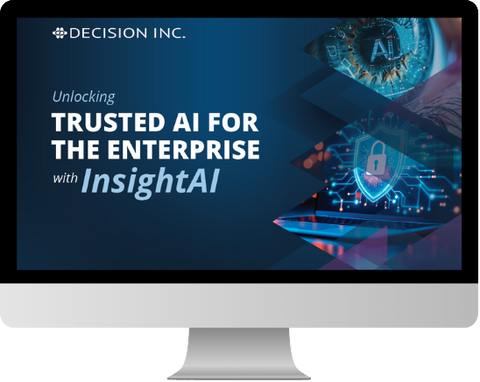ARTICLE | ARTIFICIAL INTELLIGENCE| POLICY ENFORCEMENT
The Key to Enforcing AI Usage Policies

10 September , 2025
– Rousseau Kluever, Executive: Data & AI, Decision Inc.
AI adoption has outpaced governance. While tools like ChatGPT and Copilot have become part of daily business life, most organisations still lack an AI policy enforcement approach that manages the risks they create. A late-2024 survey found only 44% of executives said their company had a generative AI policy in place, leaving the majority exposed.
And big name companies are realising this risk: Samsung banned staff use of ChatGPT after sensitive source code was pasted into the tool; Apple restricted employee use of external AI tools over leakage concerns; JPMorgan limited staff access to ChatGPT; even Amazon warned employees not to share confidential information with public chatbots.
To truly reduce risk and unlock value, organisations must go beyond policy on paper and create an environment where rules are enforced. This article looks at where companies stumble, what enforcement looks like in practice, and the steps to get there.

The Policy Gap in Practice
Many organisations have no clear ownership of AI risk, no framework for oversight, and no alignment between IT, data and compliance teams. Governance is often treated as an afterthought, something to address once experimentation is already well underway.
Meanwhile, employees aren’t waiting for permission. Many are already using generative AI without any guardrails. Research shows about half of professionals turn to unapproved tools for simple tasks like writing emails or condensing documents. The risk is that these small actions can leak sensitive data, breach compliance rules, or generate results no one can audit.
Even among companies that do have policies, many are high-level “acceptable use” statements that fail to address the practicalities of enforcement. Employees are told what not to do but aren’t given an environment where compliance is simple and natural. The result is predictable: policies are ignored, and business leaders assume more protection than exists. This enforcement gap is where the real risk lies.
Why Written Policies Fail in Practice
Publishing an AI policy is only the first step. Too often these documents outline high-level principles such as “don’t share sensitive data” or “don’t use unapproved tools” without giving employees a practical way to comply. The result is a gap between intention and reality.
There are three common reasons these policies fall short:
No technical enforcement. Without guardrails built into the tools themselves, policies rely on employee memory and goodwill. In practice, people default to convenience.
No auditability. If usage isn’t logged or monitored, there is no way to prove compliance, trace incidents, or respond to regulators. Policies become promises no one can verify.
No alignment with daily workflows. Employees are told what not to do but still need to get work done. Without an environment designed around compliance, staff will turn to the tools that make their jobs easier, even if that means ignoring policy.
Until rules are embedded in the environment where employees use AI, organisations will continue to carry hidden risks and a false sense of security.

Approaches to Enforcement
Once leaders recognise that policies alone won’t protect them, the next question is how to enforce the rules. Most organisations take one of three paths:

Training and trust. Employees are briefed on acceptable use and reminded not to paste sensitive data into public tools. This approach is quick and cheap but depends entirely on user behaviour.
Blocking public AI tools. Some companies, especially in regulated sectors, ban ChatGPT, Deepseek and similar platforms outright. This reduces risk but kills productivity and often drives staff to find workarounds.
Creating a governed environment. This means a secure, in-tenant AI platform where policies are enforced by design. Controls such as Active Directory permissions, term blacklisting and audit logging make compliance automatic rather than optional.
Only the third path offers a balance between safety and productivity. It enables employees to benefit from AI while giving IT and compliance leaders confidence that policies are being followed.
A Secure, Governed AI Platform for the Enterprise
The most effective way to close the enforcement gap is to centralise AI usage in a platform built for control and compliance. Instead of relying on staff to follow written policies, organisations need an enterprise AI platform that enforces rules by design.
InsightAI is that platform. It acts as a secure, in-tenant AI environment where governance is embedded at every level, from access permissions to data handling to audit trails. By bringing AI use into one governed workspace, it allows companies to balance productivity with risk management.
Key enforcement features include:
Active Directory integration so role-based access and permissions follow your existing identity structure.
Personal information management that automatically detects and removes personally identifiable information, supporting POPIA and GDPR compliance.
Logging and retention that provides a complete, auditable record of usage.
Blacklisting terms to stop sensitive phrases, client names or project codes from being shared.
Policy management to configure, assign and version rules for prompts, sources, retention and review workflows.
Governed web search so employees can query the web safely within approved boundaries.
With these controls in place, policies move from documents to daily practice. CIOs reduce risk from shadow AI. CDOs ensure usage aligns with governed data sources. IT Security gains a single audit surface. For the wider business, AI adoption becomes safe, scalable and compliant.
AI policy without enforcement leaves organisations exposed. The way forward is to embed governance directly into the environment where AI is used.
For a closer look at how this can be done, visit the InsightAI page below.

About Decision Inc.
Decision Inc. is your advisory-led cloud & AI partner, combining deep contextual insight and Architecture expertise with the scale to accelerate your move from strategic intent to measurable outcome.
Learn more at www.decisioninc.com.
